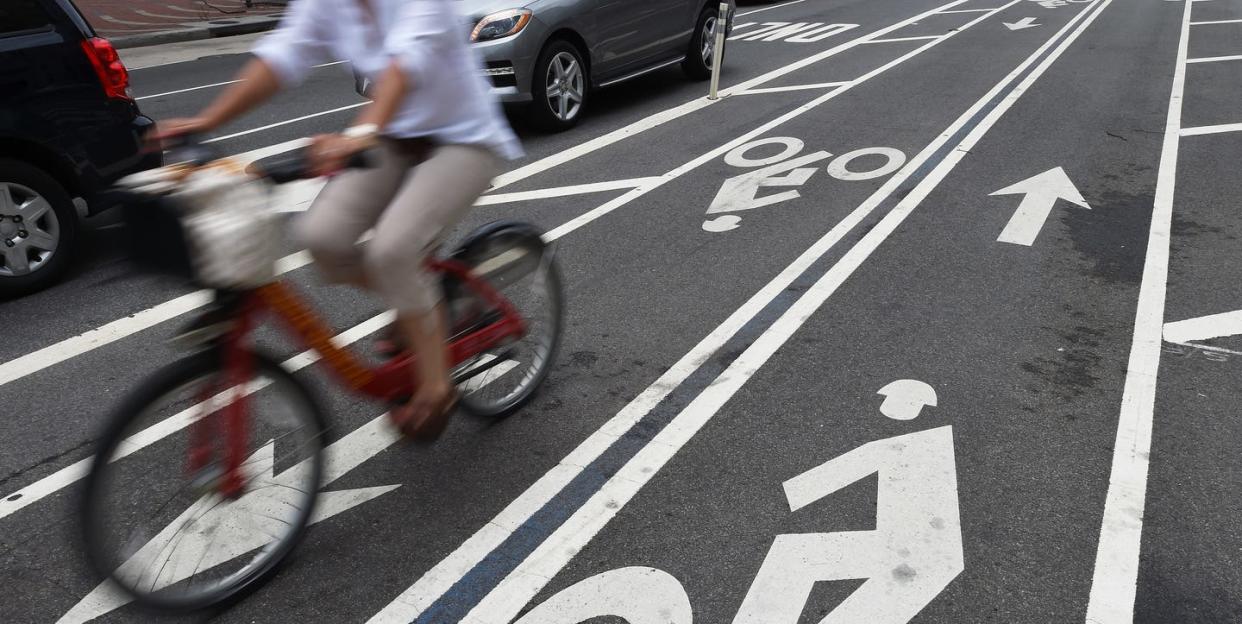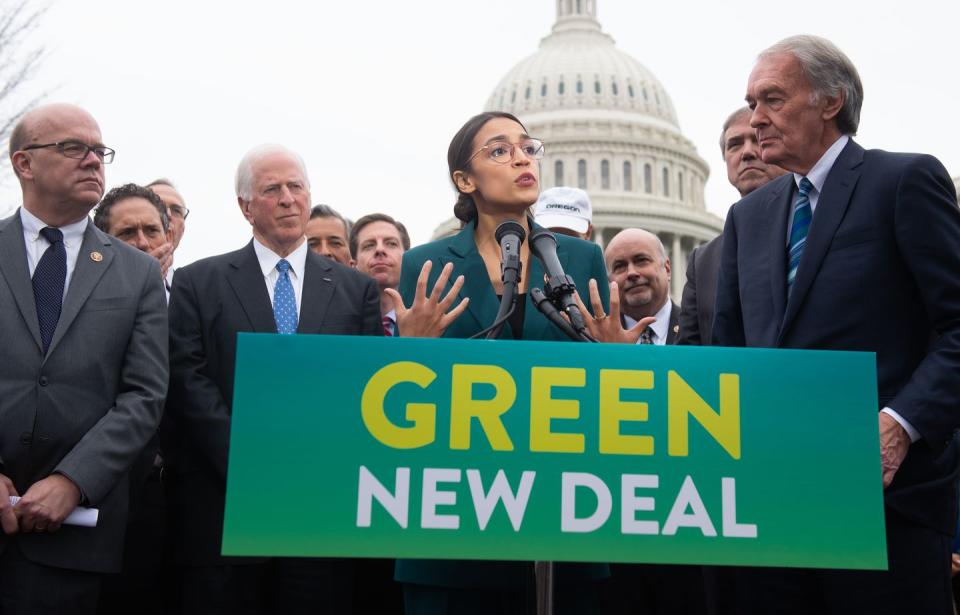To Fight Climate Change, the Green New Deal Must Embrace Cycling

It was a campaign promise, and now it’s a reality (or, at least, a proposed resolution): The Green New Deal, authored by Rep. Alexandria Ocasio-Cortez, was submitted to Congress on Thursday to loads of press coverage and fanfare. If made into law, the GND promises to remake the economy, eliminate carbon in our atmosphere, and provide for a sustainable future.
There’s no better time for the U.S. to lead the world into a greener 21st century. As noted by the United Nations late last year, if global temperatures rise by 1.5 degrees Celsius by 2030, environmental disasters-like wildfires, droughts, and floods-will increase dramatically. Right now, temperatures are on track to rise by as much as 3 degrees.
It’s a problem that needs solving, but a solution can’t happen without taking on one of the worst climate-change culprits: transportation. Currently, it makes up 28 percent of greenhouse gas emissions, according to the Environmental Protection Agency. The U.S. is responsible for 20 percent of the world’s emissions, so changing the way Americans get around will play a vital role in changing our future.
And therein lies a potential issue. Though its overarching goal is ambitious, the GND made no direct reference to cycling in its 14-page first draft.

In fact, the only mention of transportation at all comes on page 8. That’s where the document comes closest to prioritizing things like cycling, walking, and public transit, setting a broad objective of “investment in zero-emission vehicle infrastructure and manufacturing; clean, affordable, and accessible public transportation; and high-speed rail.”
While more robust public transit is essential, the bicycle’s place in reining in emissions cannot be understated. More than half of all motor vehicle trips taken in the U.S. are between one and 10 miles, according to the Federal Highway Administration. As noted by the Institute for Transportation and Development Policy, a 20 percent increase in cycling worldwide would “cut carbon dioxide emissions from urban passenger transport by nearly 11 percent in 2050.”
For many bike commuters, a lower carbon footprint is a secondary benefit to the daily exercise, money saved, and efficient movement offered by riding a bike. The fact that so many people have already made the transition from cars to bikes-cycling grew by 43 percent nationwide between 2000 and 2017-is proof that the federal government can, and should, make new investments in cycling. To cut down (or completely cut out) greenhouse gases in the U.S., bike facilities will need more direct funding and support from Washington.
And not just in terms of pure dollars. The GND could create a new system of block grants for cities that want to install protected bike lanes and other facilities. Getting federal money to build something is convoluted and confusing: The pot of cash is too small, and it’s too hard to obtain. A bike trail, if federally funded, has to go through the same sort of reviews a highway does, making it an often years-long process.
Simplifying this process should be a priority, as should providing more incentives toward bicycling. Getting there is simple, if politically risky: A carbon tax and higher gas taxes will make driving more expensive. With higher prices-coupled with better, more abundant non-car travel options-more people will choose to bike, especially in dense, urban areas.
Ocasio-Cortez has waded into the politics of cycling before. Last June she cautiously noted a debate over a bike lane in her New York City district, coming out generally in favor of adding more bike infrastructure in Queens. She later joined a ride with bike advocates, but mentioned that she doesn’t normally bike herself because “it’s too dangerous in the [Bronx].” (Her district spans parts of both Queens and the Bronx.)
Our future Congressional rep just came on a #BikeQNS adventure to talk #safestreets in the district and ride on our amazing #protectedbikelanes! @Ocasio2018 #SaferSkillman #FixQueensBlvd #Safer111 pic.twitter.com/VJopzH3Ppt
- Laura Shepard (@LAShepard221) July 14, 2018
That’s fair: The advocacy group People for Bikes found that while more than half of Americans said they would like to bike more often, a slightly greater percentage said they fear getting hit by a car while riding. A little less than half said they “would be more likely to ride a bicycle if motor vehicles and bicycles were physically separated.”
But we hope Ocasio-Cortez can view her plan as a rare opportunity to completely rethink transportation. A greener future would require a holistic approach that accounts for cycling, walking, transit, zoning, street design, and other factors so cities can build less car-dependent environments. Ideally, the Green New Deal is what makes places like her home in the Bronx safe for cycling.
The vagueness of the young GND leaves it open for change-and it’s up to cycling advocates to become part of the conversation, and the solution, on climate. The plan’s first draft is, in part, proof of how far we have to go to normalize the most efficient form of transportation that exists.
('You Might Also Like',)

